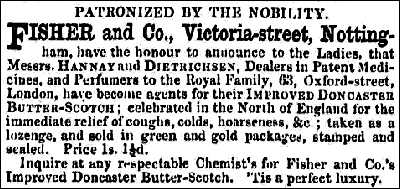Butterscotch
Q From Peter Zilahy Ingerman: If I’ve managed to get it straight (a dubious proposition at best, of course), caramel is the result of pyrolising sugar syrup. I was under the impression that butterscotch is similar, but is made from honey (though the definitions I can find seem to suggest that it’s actually butter and brown sugar). This leads to two questions: a) what is butterscotch, and b) why is it called that?
A Don’t look to me for culinary advice — I can burn boiled eggs. My books say that butterscotch is indeed a form of caramel, but made with butter and brown sugar, as you describe, plus a touch of vanilla. That’s the limit of my expertise.
Unfortunately, I can’t do that much better with your second query. Nobody seems to know. Some argue that the second part is actually scorch, from the manner of its making. The Collins Dictionary says that it may have been called that because it was first made in Scotland. Neither suggestion is supported by evidence, though the Scottish link seems plausible because Keillers of Dundee was one firm that made butterscotch commercially.
The Oxford English Dictionary’s first citation (indeed, its only citation) is from 1865. It’s not hard to take that back a while: the first example I can find is from The Boy’s Autumn Book of 1847. Although that was published in New York it quotes a British itinerant seller of sweets. It’s worth quoting at some length for the period flavour (to coin a phrase):
Well, you know, next morning I put my things in my cart, ready for Nottingham goose-fair: the brandy-balls here, by themselves—the butter-scotch there—the tuffey in this place—the black-jack in that; then I filled in with cure-all, and hard-bake, and peppermint pincushions: really it was beautiful to look at, I’d done it so nicely.
Wikipedia states that the first maker of butterscotch was Samuel Parkinson of Doncaster, in 1817. The firm did make it during the nineteenth century and Doncaster became famous for it. The Parkinson papers are deposited at the Doncaster Archives, from where Dr Charles Kelham tells me they begin only in 1848, although an article published in The Doncaster Review in September 1896 asserts that “It was on the 11th of May 1817, that the late Mr. Samuel Parkinson commenced the manufacture of butter-scotch.” If he did so, it may be unlikely, from the lack of written evidence before 1847, that he called it by that name.

An advertisment found by subscriber Gemma Dearing in The Lady’s Newspaper of London, dated 20 March 1847. The word “improved” certainly suggests that butterscotch was known by that name rather earlier.
Other writers argue that the sweetmeat has no link with Scotland. Charles Earl Funk noted in Horsefeathers in 1958: “All directions for the preparation of this candy after it is properly cooked close with some such statement as: Pour upon oiled paper or well-buttered pan and when slightly cool score with a knife into squares.” He points out that one sense of scotch was to score or cut a shallow groove in something.
This seems more reasonable than to assume it was originally Scots, especially in view of the known early history of its manufacture in England. But, as often with word histories, it can’t be proved.
